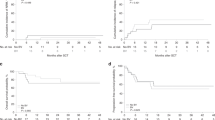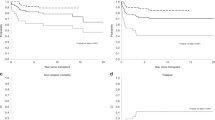Abstract
The aim of the study was to retrospectively evaluate the outcome of patients with aggressive non-Hodgkin’s lymphoma (NHL), undergoing autologous stem cell transplantation (ASCT) in first complete (CR) or partial (PR) remission, according to the age-adjusted International Prognostic Index (IPI). Fifty-two consecutive patients, aged less than 60 years, with intermediate- or high-grade NHL, and at least one of the following adverse risk factors: bulky disease, B symptoms or Ann Arbor stage III–IV, and at least a PR after CHT (and radiotherapy (RT) on residual mediastinal mass when required), underwent ASCT conditioned with BAVC. Sixty-five percent (33/52) of the patients achieved CR after CHT; 69% (36/52) after CHT + RT; 90% (47/52) after CHT ± RT + ASCT. One death during conditioning and three major toxic events after ASCT were recorded. Overall survival (OS) is 98% at 37 months (16–88); disease-free survival (DFS) is 100% at 27 months (7–82). Comparing the observed results with those expected if patients were treated only with CHT, the sequential treatment including ASCT conferred an advantage in terms of CR rate of 14, 23 and 54%, respectively, in the low-intermediate (LI), high-intermediate (HI) and high (H)-risk groups, respectively. The 2-year OS advantage is 10, 21, 31 and 63%, respectively, and the 2-year DFS advantage is 12, 26, 38 and 39%, respectively. Even more striking is the 5-year projected advantage in the number of patients alive without disease, even when considering only the low (L) (P < 0.0001) and the li (P < 0.0001) risk groups. for patients in the higher (hi + h) risk groups, asct should be included in the initial plan of treatment as consolidation of first cr or pr, but the differences seen in this study suggest a formal comparison in a randomized study also for patients in the li risk group.
This is a preview of subscription content, access via your institution
Access options
Subscribe to this journal
Receive 12 print issues and online access
$259.00 per year
only $21.58 per issue
Buy this article
- Purchase on Springer Link
- Instant access to full article PDF
Prices may be subject to local taxes which are calculated during checkout
Similar content being viewed by others
Author information
Authors and Affiliations
Rights and permissions
About this article
Cite this article
Fanin, R., Silvestri, F., Geromin, A. et al. Autologous stem cell transplantation for aggressive non-Hodgkin’s lymphomas in first complete or partial remission: a retrospective analysis of the outcome of 52 patients according to the age-adjusted International Prognostic Index. Bone Marrow Transplant 21, 263–271 (1998). https://doi.org/10.1038/sj.bmt.1701081
Received:
Accepted:
Published:
Issue Date:
DOI: https://doi.org/10.1038/sj.bmt.1701081



